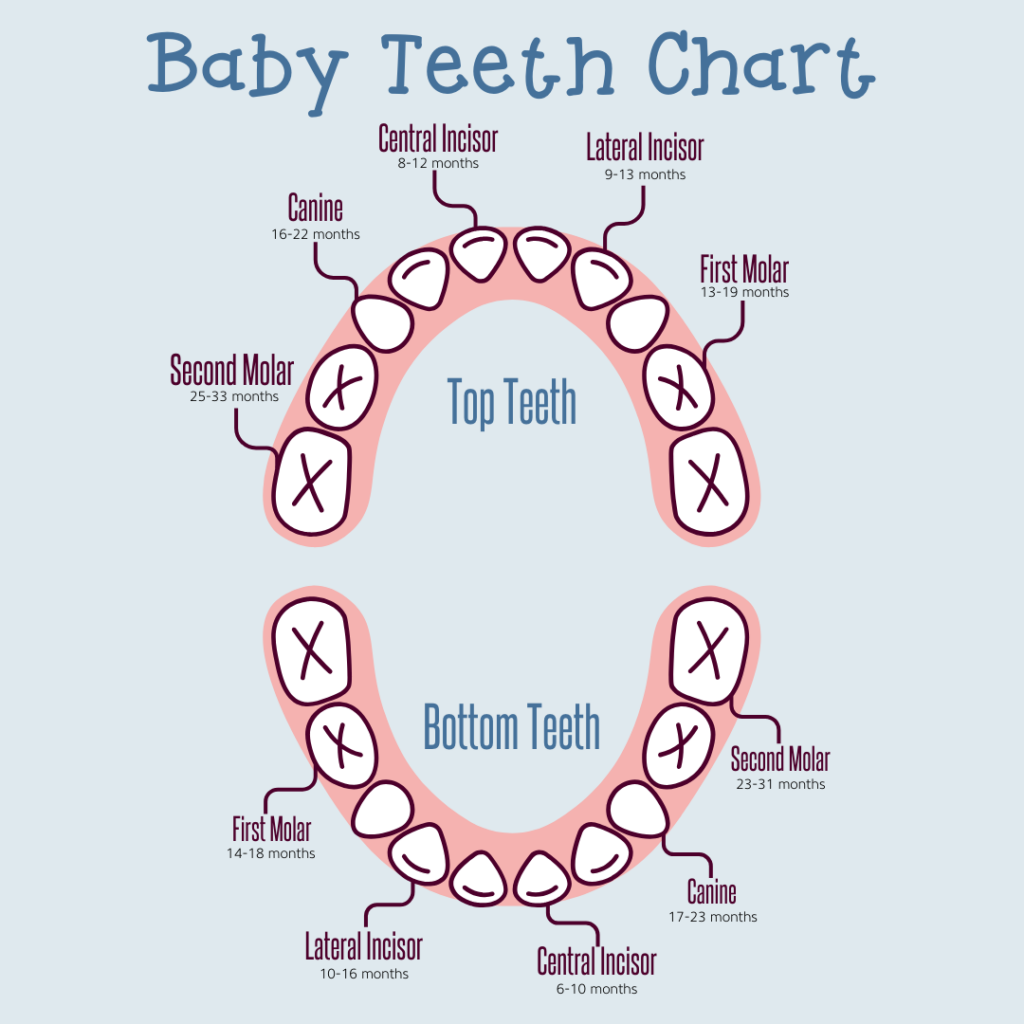Childhood is a magical time with many important moments like speaking, walking, and getting the first tooth. Understanding how children’s teeth develop is important for taking care of their growing smiles in early years.
In this post, we discuss the journey of kids growing and losing their teeth. We also discuss each tooth in a child’s first set (also known as primary teeth, baby teeth, or deciduous teeth) and what happens when they fall out.
In What Order Do Baby Teeth Appear?
Babies start getting their first teeth when they are 6 to 12 months old. By the time they are 2 1/2 – 3 years old, most, if not all 20 of their teeth will be in place.
This initial set of baby teeth play an important role in a child’s life. They help with chewing and digestion, support speech development, and save space for adult teeth. We can take a closer look at the journey of the primary teeth with this baby teeth chart. A baby teeth chart shows you when each of your child’s first set of teeth is likely to come in and then fall out.

Every child is different, so the time when their baby teeth come in or fall out can change from one to another. But, the table below shows around what age you can expect baby teeth to show up.
| Lower Central Incisors | 6 – 10 months | The two front teeth are usually the first teeth to appear. They are the two front bottom teeth, located in the middle of the lower jaw. |
| Upper Central Incisors | 8 – 12 months | Following suit, are the upper central incisors. These teeth mirror their lower counterparts and complete the set of your child’s front four teeth. |
| Upper Lateral Incisors | 10 – 13 months | The upper lateral incisors are the teeth on either side of the front two teeth. They will appear shortly after one another. |
| Lower Lateral Incisor | 10-16 months | The lower lateral incisors will appear at the same time or shortly thereafter. They will appear on either side of the two bottom front teeth. |
| Upper First Molar | 13-19 months | Nestled at the rear of the mouth directly behind the canines are the first molars. |
| Lower First Molar | 14-18 months | The lower first molar will erupt around the same time as the upper first molar. |
| Upper Canine | 16-22 months | Canines are the pointy teeth, and they get their name because they look like a dog’s fangs. |
| Lower Canine | 17-23 months | The lower canines will appear around the same time as the upper canines. Most people have four canine teeth. |
| Lower Second Molar | 22-31 months | The lower second molars in the back of the mouth are responsible for most of our chewing. |
| Upper Second Molar | 25-33 months | The upper second molars are the last to make an appearance. |
When Will Your Child’s Baby Teeth Fall Out?
Typically, this occurs when they are about 6 or 7 years old. This happens because their permanent teeth are kicking their 20 primary teeth to the curb. While each child’s journey is unique, primary teeth typically fall out following this rough timeline:
| Lower Central Incisors | 6-7 years old |
| Upper Central Incisors | 7-8 years old |
| Lateral Incisors | 7-8 years old |
| First Molars | 9-11 years old |
| Canines | 10-12 years old |
| Second Molars | 10-12 years |
What’s The Difference Between Primary Teeth & Permanent Teeth?
The biggest difference between primary teeth and permanent teeth is the number of teeth. Children have 20 total teeth, 10 on the top and 10 on the bottom, while adults may have 32 total teeth. When children naturally shed their primary teeth, they pave the way for an additional 12 teeth, including:
- 8 Premolars: Premolars, also called bicuspids, sit between the canines and the first molar on both the top and bottom jaw.
- 4 Third Molars: Commonly referred to as Wisdom Teeth burrowed at the back of the mouth.
Your child’s journey of growing and losing teeth is crucial for their development. It can be an exciting time, especially with the possibility of a visit from the Tooth Fairy. Parents and children can feel more confident and enjoy important milestones by understanding the order in which they occur.